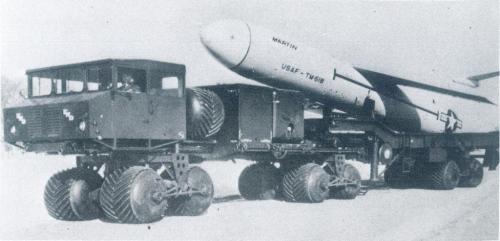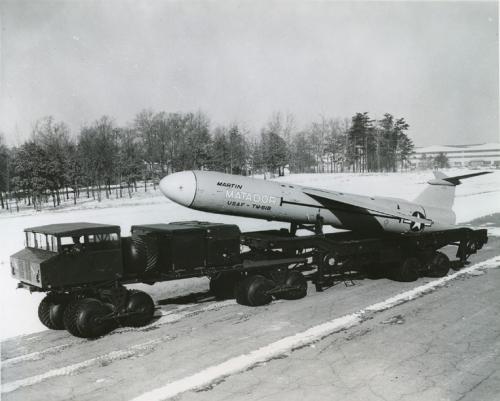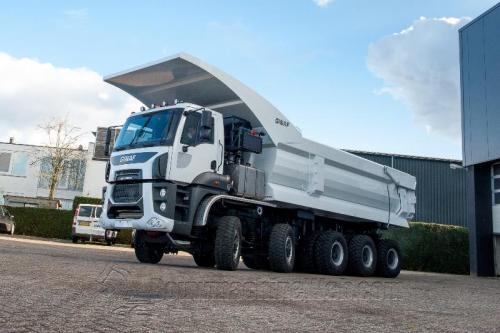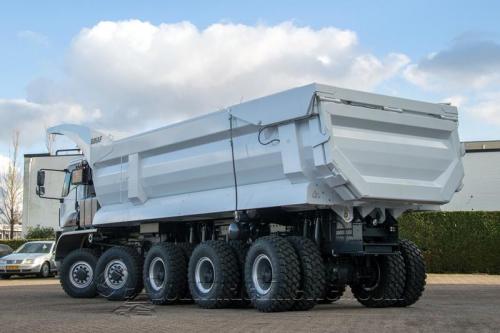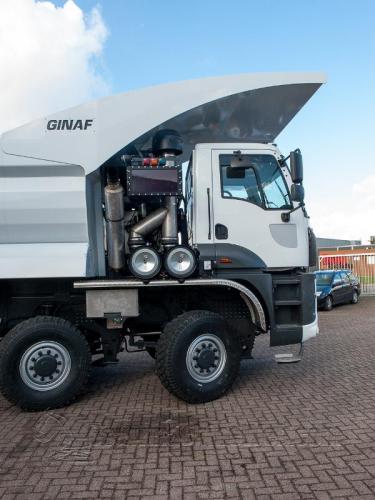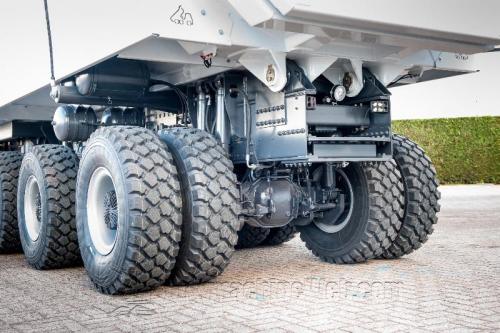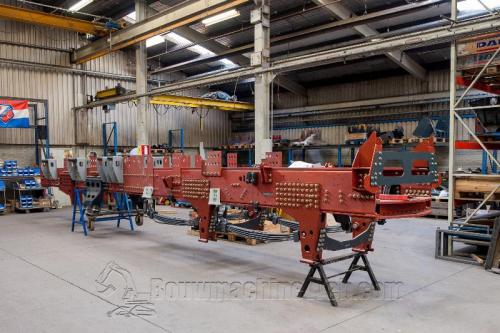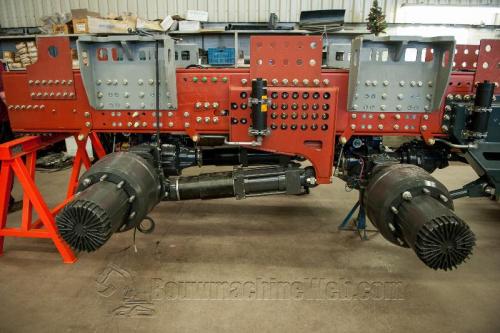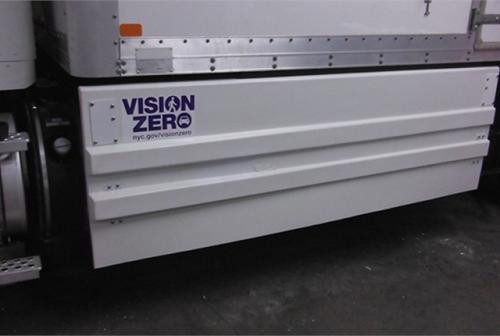
kscarbel2
Moderator-
Posts
18,538 -
Joined
-
Days Won
112
Content Type
Profiles
Forums
Gallery
Events
Blogs
BMT Wiki
Collections
Store
Everything posted by kscarbel2
-
For Sale Ex USAF 1957 FWD MM1 Terracruzer
kscarbel2 replied to General Ike's topic in Other Truck Makes
-
For Sale Ex USAF 1957 FWD MM1 Terracruzer
kscarbel2 replied to General Ike's topic in Other Truck Makes
FWD produced several different Teracruzers. This is a Model 8-320 B. It used a PE 200 "Continental Packett" 4-cycle 8-cylinder opposed piston air-cooled engine developing 250 horsepower at 2,800rpm. An Allison TX-340 semi-automatic 4-speed transmission drove the two bogies thru an FWD-built central differential. The air pressure of the 40x42 inch Goodyear Terra-Tires could be adjusted between 3 and 18 psi from within the cab. Cruise speed was 40mph, and it could climb a 60 percent slope at 2.5mph. It was designed to pull a missile trailer carrying a 40 foot long Martin TM-61 Matador land-based missile which operated at 35,000 feet and 650 mph, or the Martin TM-76 Mace. -
another v8 cl gone.
kscarbel2 replied to mack mhe9's topic in Antique and Classic Mack Trucks General Discussion
The former Mack Trucks believed in offering glider kits. Volvo however does not. -
another v8 cl gone.
kscarbel2 replied to mack mhe9's topic in Antique and Classic Mack Trucks General Discussion
In inches....... A standard CH600 frame rail was 10.0 x 3.38 x .24" (straight rail design) Optional was 10.16 x 3.46 x .31" The standard MH600 and RW600 (at the rear behind the spread) was 9.37 x 3.31 x .24" The optional MH600 and RW700 (at the rear behind the spread) was 10.8 x 3.4 x .39" The CL600 (at the rear behind the spread) was 9.37 x 3.31 x .24" The CL700 (at the rear behind the spread) was 10.8 x 3.25 x .39" -
Question about the new Mack's
kscarbel2 replied to bullhusk's topic in Modern Mack Truck General Discussion
The DD13, DD15 and DD16 (M-B OM471, OM472 and OM473) are irrefutably the best powerplants available in the US market today, and superior to the Volvo engine in the Mack. Thus, if you buy the Mack brand truck, you're not getting the best value engine wise with regard to fuel economy, performance and durability. -
Question about the new Mack's
kscarbel2 replied to bullhusk's topic in Modern Mack Truck General Discussion
The set-forward axle Pinnacle Rawhide Edition would be Coronado equivalent. However, the mid- and high-rise sleeper opening begins behind the driver, rather than at the front windshield on a Freightliner, resulting in less move-around interior space. And the cab isn't as wide. It feels cramped when compared to the Freightliners you run. This is one reason the Mack brand has not been very successful in this segment. http://www.macktrucks.com/~/media/files/brochures/mack_highway_brochure.ashx?as=1&sc=1 And if you like air ride, you might be limited to the convoluted Volvo-design "Twin Y" air suspension. To date, it's been a sales disaster. -
Press Release / February 19, 2014 Walmart Canada's Supercube is a 60-foot, 6-inch trailer combined with a COE tractor and drome box. It allows Walmart to ship up to 40 percent more merchandise compared to a standard 53-foot tractor-trailer combination. The company says it reduces transportation costs by 24 percent, and greenhouse emissions by 14 percent. For more information: http://www.bigmacktrucks.com/index.php?/topic/34233-wal-mart-to-expand-test-use-of-supercube-concept-in-canada/?hl=wal-mart
-
The U.S. Department of Energy / December 24, 2014 TransPower ElecTruck, the Class 8 pure battery-electric tractor with a 60 to 120 mile range under normal operating conditions, with a GCWR of up to 80,000 pounds. Video: Reference: http://www.bigmacktrucks.com/index.php?/topic/35887-transpower-unveils-their-latest-generation-electric-heavy-truck/?hl=transpower
-
The new Ginaf HD5395TS was recently shown to the press. It's certainly a very professional application of Ford's "Cargo" heavy truck cab. Specifications: Engine: Cummins QSX15 Engine power: 449 kW (610 hp) at 1900 rev / min Engine size: 14.9 liters Transmission: ZF AS Tronic 12AS3141TO with GINAF HD Mining Shift software Engine brake: 360 kW at 2300 r / min + ZF Intarder 600 kW Front axles: 13 tons Sisu (2x) Rear axles: 23 tons Sisu (3x) Suspension - Front axles: parabolic springs with four bellows per axle Suspension - Rear axles: HD HPVS hydropneumatic Tires: XZL Michelin 395 / 85R20 Maximum travel speed: 69 km / h (empty limited to 60 km / h, loaded 40 km / h) Fuel capacity: 400 liters Trailer: KH 32 m³ (water content) Dump body cycle times: 29 seconds Load capacity: 70,000 kg Curb weight: 25,000 kg .
-
Press Release / February 9, 2015 Scania application engineers ensure the company’s marine and industrial engines are perfectly married to the equipment of customers. Training days that put these professionals into real-life situations ensure that their skills are up-to-date and of maximum benefit. It’s a grey autumn day in Sweden’s capital city Stockholm and in the coastal suburb of Dalarö the temperature is sitting just above zero. But down in the engine room of the Swedish Sea Rescue Society vessel Björn Christer things are toasty and warm. A group of six application engineers are gathered around the boat’s twin Scania engines and Max Lindqvist, Lead Engineer, Marine & Power Generation Engines, is explaining the latest methods for assessing engine performance. “The boat belongs to the Swedish sea rescue society and they have been very kind to let us undertake training on their boat,” Lindqvist explains later during a break. “It’s equipped with two Scania V8s with 1,000 horsepower each that makes it run at 35-36 knots. So it’s quite a fast vessel.” Outstanding engineers A total of 20 application engineers from Scania distributor across the globe are involved in this week’s training, with participants coming from as far afield as Australia, Burma, Lebanon and Brazil. Lindqvist explains the idea behind the training is educate outstanding engineers from each market so that they can return and share their knowledge with colleagues, thus inspiring excellence. Scania aims to stage such events every two years or so, so that the most up-to-date knowledge makes its way to the marketplace. The training component on-board the Björn Christer involves assessing how efficiently the power generated by the vessel’s Scania engines is being transferred to the water jets. “We conduct physical tests, run the engine, log data and draw diagrams showing how the engine interacts with the propulsion system,” says Lindqvist. After examining the engine physically, the group heads up to the main deck where a laptop computer has been connected to the vessel’s engine control unit (ECU). The computer has been fitted with SDP3, Scania’s PC -based diagnostics application software for engines. As the group huddles around the screen, a long list of engine performance variables is continually updated. The boat’s pilot then increases engine speed in 100 rpm increments, allowing the engineers to assess performance at various stages of load. After examining the data Lindqvist is able to declare that the engine is operating efficiently. “It’s pretty good,” he says. “It’s a close match to the rated speed. We’ve also looked at acceleration performance and the engine revved up really well.” “Makes it more real” As well as training on-board the Björn Christer, engineers will today attend lectures on the features of engine control units and on marine power definition. Tomorrow the work will focus on topics including power generation and vibration assessment. Dean Rippon, an application engineer from the UK, who took part in the training says getting out in the field has real advantages for learning. “It makes it more real life,” he says. “As well as sitting in the classroom talking about the theory side, we also do the practical side, actually being on the boat and experiencing it first hand.” Rippon says there are multiple benefits to attending such training. “You’ve got to keep up with the latest technologies and talking to people from other markets also helps. It brings great value to the customer they can see that we’re experienced in what we do we can approach it more professionally.” Michael De Clercq, an application engineer from Belgium, says it’s crucial that customers get the best installation possible for their engine. “It’s important because we are selling a premium product,” he says. “We need to make sure that the engine is installed in a good vessel, and that the installation performs to the same high standard as the engine itself.” For more information: http://newsroom.scania.com/en-group/2015/02/09/inside-scanias-floating-classroom/
-
NYC Adding Truck Side Guards to Protect Pedestrians, Cyclists
kscarbel2 replied to kscarbel2's topic in Trucking News
I can tell you that side underrun protection does not cost the customer US$3000 on a Scania tractor or rigid. In fact, the total cost of front, side and rear underrun protection does not cost the customer even half that. The $3000 figure noted here represents a vendor milking the situation. Example: Side underrun protection on an Iveco Eurocargo rigid: http://www.tecnove.com/wp-content/uploads/2012/10/Image319.jpg Example: Side underrun protection on a B-Double (aka. Interlink, B-Train): http://www.primemovermag.com.au/images/uploads/trailer/articles/TM0410-Tieman-1.jpg -
Heavy Duty Trucking / February 9, 2015 Allison Transmission Holdings Inc. on Monday reported gains in both profit and revenue for the final quarter of last year and for all of 2014. Net income totaled $50.5 million in the final quarter compared to $42.9 million a year earlier, or diluted earnings per share of 28 cents versus 23 cents. Net sales on the fourth quarter were $544 million, an 11% increase from the same period in 2013. The increase in net sales was principally driven by the continued recoveries in the North America on-highway and off-highway end markets, and higher demand in the service parts, support equipment and other end market, partially offset by lower demand in the outside North America on-highway and North America hybrid-propulsion systems for transit bus end markets, according to the Indiana-based maker of transmissions for medium-duty and heavy-duty vehicles. For all of last year, Allison had net income of $228.6 million compared $165.4 a year earlier, or diluted earnings per share of $1.25 compared to 88 cents during the same comparable time periods. “Our fourth quarter 2014 results exceed the guidance ranges we provided to the market on Oct. 2,” said Lawrence E. Dewey, chairman, president and CEO. “Allison continued to demonstrate strong operating margins and free cash flow while investing in growth opportunities despite challenging conditions in the outside North America end markets.” North America on-highway end market net sales were up 22% from the same period in 2013, principally driven by higher demand for Rugged Duty series models and flat on a sequential basis due to higher demand for Highway Series models, according to the company. Allison said outside North America, on-highway end market net sales were down 24% from the same period in 2013, reflecting weakness in China’s bus and the European truck market, and down 11% on a sequential basis due to lower demand in China’s bus and truck markets and Japan’s truck market. The company’s service parts, support equipment and other end market net sales were up 13% from the same period in 2013 principally driven, it said, by higher demand for North America off-highway service parts, and down 4% on a sequential basis due to lower demand for North America on-highway service parts consistent with seasonal aftermarket activity levels and global on-highway support equipment commensurate with decreased transmission unit volumes, partially offset by higher demand for North America off-highway service parts. Allison expects 2015 net sales to be in the range of flat to down 5% compared to 2014. “Our 2015 net sales guidance reflects a cautious approach given the heightened level of uncertainty and the lack of near-term visibility and confidence in the global Off-Highway end markets,” the company said in a statement. “Allison's 2015 net sales outlook also assumes a continued recovery in the North America on-highway end market, previously considered reductions in U.S. defense spending, continued weakness in the outside North America on-highway end market and lower demand for North America hybrid-propulsion systems for transit bus due to engine emissions improvements and non-hybrid alternatives” While Allison did not provider specific first quarter 2015 guidance, it does expect first quarter net sales to be higher than the same period in 2014. “The anticipated year-over-year increase in first quarter net sales is principally driven by higher demand in the North America on-highway and off-highway end markets, partially offset by previously considered reductions in defense net sales and lower demand in the North America hybrid-propulsion systems for transit bus end market,” the company said.
-
Heavy Duty Trucking / February 9, 2015 New York City will begin adding side guards to 240 of its medium-duty trucks that will prevent a pedestrian or cyclist from being caught under a vehicle during a collision, Mayor Bill de Blasio has announced. The initiative, which is part of the city's Vision Zero program, will initially bring side guards to 18 trucks; the city will retrofit the remaining 222 by the end of the year. The city operates a fleet of more than 27,000 vehicles. "When we change the way we do business like this, it changes our streets for the better," said Stacey Cumberbatch, commissioner of the Department of Citywide Administrative Services. "DCAS is working in partnership with City agencies to improve safety for the public and our drivers including installing these life-saving side guards." The city moved forward with the installation of the side guards after cyclist Hoyt Jacobs — a 36-year-old poet and Queens College adjunct professor — was struck and killed in Long Island City by a sanitation truck Jan. 17, said Council Member Ydanis Rodriguez. "Last month, in response to the first cyclist death of 2015, I called upon our Mayor to install side guards on the City truck fleet in order to end these preventable accidents," Rodriguez said. The guards cost about $3,000 each to purchase and install. "Side guards have a proven record of preventing fatalities and injuries on the road and are a worthy investment of tax-payer dollars," said Council Member Julissa Ferreras, who chairs the finance committee. The department began studying whether to install the guards in May, when it began a partnership with the Volpe Center at the U.S. Department of Transportation. The research included a review of international standards for side-guard use and exemptions, according to a city release. Volpe Center officials reviewed each city department's specific equipment, and issued a final report identifying 4,734 trucks eligible for the side guards. Trucks with a gross vehicle weight under 10,000 pounds were exempted. As part of Vision Zero, DCAS has been tracking and analyzing collisions involving city vehicles. The city has expanded its defensive driving training and has installed telematics systems on city vehicles to better monitor driving behavior. FYI: The United Nations Economic Commision for Europe (ECE) Council Directive 89/297/EEC of 13 April 1989 mandates side underrun protection on heavy goods vehicles to prevent pedestrians, bicycle riders and motorcyclists from falling under the wheels of the heavy good vehicle when it turns. Front, side and rear underrun protection should be mandatory in the United States, The added costs is negligable, and the safety benefits irrefutable. It's an embarassment that the EU in this regard is 25 years ahead of the United States. .
-
Industry groups back 160km work diary exemption and want Victoria to introduce it to ensure national uniformity. Australasian Transport News / February 9, 2015 The body representing livestock transporters across Australia has welcomed the introduction of a work diary exemption in South Australia, and it is now turning its attention to getting it in place in Victoria. The Australian Livestock and Rural Transporters Association (ALRTA) has congratulated the National Heavy Vehicle Regulator (NHVR) and the South Australian Government for exempting certain truck drivers from having to fill out a work diary in the state. As in New South Wales and Queensland, drivers in SA will no longer need to record their movements if they are moving primary produce within 160km (99.4 miles) of their home base. The measure has also been introduced in the Australian Capital Territory and is due to begin in Tasmania on March 30. ALRTA president Grant Robins says the NHVR’s announcement shows it can effectively work with jurisdictions operating under national trucking law to deliver more consistency for transport operators. "The primary aim of the Heavy Vehicle National Law has been to reduce or remove regulatory differences between the states and territories," Robins says. The SA Livestock and Rural Transporters Association has thanked SA transport minister Stephen Mullghan for supporting the exemption. "This is an excellent step towards bringing South Australian heavy vehicle regulation into line with competing states," president David Smith says. He adds that the exemption will reduce the volume of paperwork without compromising safety. The ALRTA and its state associations have been campaigning since July last year for national consistency on work diary exemptions. It says the standard 100km exemption should be set at 160km for rural carriers because the local areas they cover are larger than their city-based counterparts, congestion is lower and average speed limits are higher. The Livestock and Rural Transporters Association of Victoria (LRTAV) is now urging the Victorian Government to agree to the 160km exemption. LRTAV president John Beer says Victorian authorities need to put aside any differences and embrace national uniformity. "The whole idea of signing up to the Heavy Vehicle National Law was that all operators would be treated equally. It makes no sense to have different rules in Victoria when every other participating state has agreed on a uniform approach," Beer says. While drivers working within 160km of their base do not need to keep a diary, company record keeper still need to keep basic information on work and rest times and payment records.
-
Wall Street Journal / February 9, 2015 Deal Provides Workers with a Combination of Wage Increases and Bonuses Members of the United Auto Workers union have ratified a four-year contract with truck maker Navistar International Corp. that will provide workers with a combination of wage increases and bonuses, while maintaining a two-tier wage scale for new hires and veteran employees. The deal approved Sunday covers a total of 1,500 workers at a truck assembly plant in Springfield, Ohio; an engine plant in Melrose Park, Ill.; and parts distribution centers in Atlanta, Dallas and York, Pa. Navistar and the union managed to reach the deal without the acrimony and output disruptions that have marked previous contract talks. “We found common ground on some difficult issues and we will continue in that spirit of cooperation as we move forward,” said Bill Osborne, senior vice president for manufacturing and quality, in a written statement. Navistar typically idled unionized plants, laid off workers and shifted production to nonunion plants when the company and the union were unable to agree on a new contract before an old contract expired. But when the contract ended on Oct. 1, the company allowed UAW members to remain on the job under the terms of the old contract while negotiations continued. “By all means, this contract [negotiation] was different,” said Jason Barlow, president of UAW Local 402, which represents about 1,000 workers at Navistar’s Springfield plant. “No one had the hardship of being laid off.” Under former Chairman and Chief Executive Dan Ustian, Navistar had a turbulent relationship with the UAW and repeatedly threatened to close the Springfield plant and move assembly work to nonunion sites in Alabama or Mexico. Current CEO Troy Clarke has been focused on rebuilding the company’s slumping market shares in medium-duty and heavy-duty trucks after a disastrous strategy for complying with federal regulations on engine emissions undermined the reliability of Navistar’s engines, causing truckers to defect to other truck brands. Mr. Barlow said Illinois-based Navistar pledged to keep the Springfield plant open and has been expanding the size of the workforce. The plant produces 83 trucks a day. About 100 assembly-line support jobs at Springfield that have been performed by nonunion contractors will become part of the unionized workforce under the new contract. Navistar last year moved some engine assembly from a nonunion plant in Huntsville, Ala., to its Melrose Park plant. In return, the union agreed to give the company greater discretion to schedule overtime and weekend shifts to accommodate the introduction of new truck models or joint ventures. The union also agreed to maintain a two-tier wage scale that pays new employees lower wages than those hired years earlier. The base starting wage under the new contract, though, will increase by $1 to $15.68 an hour. For ratifying the contract Sunday, UAW members will receive $1,000 bonuses. Production, maintenance and clerical workers will receive 2% wage increases in the second and fourth years of the contract and lump-sum bonuses in the first and third years of the deal. Employees will be eligible for annual profit-sharing bonuses when Navistar makes a profit. The contract expires Oct. 1, 2018. The union didn’t provide specific vote totals from the contract ratification, but Mr. Barlow said the deal was approved by three-quarters of those who voted Sunday. “Everybody is going to make more money,” Mr. Barlow said. “It worked out for us.”
-
Associated Press / February 6, 2015 Swedish truck maker AB Volvo has posted a fourth-quarter loss of 3 billion kronor ($364 million), compared with a 548 million-kronor surplus last year, in the face of weak demand for construction equipment. The Goteborg-based company says sales in the last three months of 2014 rose slightly to 77.5 billion kronor ($638.249) from 76.6 billion kronor in the same period last year. Volvo Group said the construction equipment business experienced "strong headwinds" as markets outside of North America continued to deteriorate. CEO Olof Persson said Thursday Volvo Trucks had reduced a net financial debt by nearly 10 billion kroner ($824 million) last year. However, "we still have a lot of hard work ahead of us."
-
Interfax / February 6, 2015 "ZAO Volvo Vostok" which has control over Volvo plants in Russia is suspending truck production at its Volvo Group Trucks plant in Kaluga and is laying off almost one-third of its staff as of February 11, the company's spokesman Oleg Vasilchenko told Interfax. The company will lay off 30% of the office staff and production line workers who will be compensated in accordance with the Russian Labor Code, he said. "The remainder of the staff will remain on the plant's payroll with their salaries. Of their numbers, about one-third will be employed as they are now for the duration of the temporary stoppage," Vasilchenko said. Trucks will be temporarily supplied to Russian customers from Volvo Group's European facilities in Sweden, Belgium and France. The decision to lay off staff and suspend production was due to the unfavorable market situation and the continuing fall in demand for commercial vehicles. It was reported earlier that the unfavorable market conditions last summer forced the company to extend the corporate summer vacation by two weeks. The Volvo Group Trucks plant opened in January 2009. The 15,000-vehicle-capacity plant makes trucks for Volvo and Renault. The plant employs 700 people.
-
Mack Factory, Plainfield, NJ Pics
kscarbel2 replied to fire4t3's topic in Antique and Classic Mack Trucks General Discussion
http://www.bigmacktrucks.com/index.php?/topic/34219-mack-trucks-the-facilities/?hl=plainfield#entry226401 -
Truck News / February 5, 2015 On Wednesday, Navistar held its first Analyst Day since February 2012, when the previous regime was still steadfastly defending its EGR-only emissions strategy. The hosting of an Analyst Day this year, and the debut of a new marketing slogan ‘It’s Uptime at International,’ suggests the truck and engine manufacturer has begun a new chapter and put behind it some of its most challenging times. There was plenty of optimism on display as the company walked visiting investment analysts and trucking journalists through its latest developments. Here are four key takeaways: Streamlining repairs Navistar executives had lots to say about the company’s OnCommand Connection remote diagnostics platform. While most OEMs already offered something similar, Navistar came to market with its system in a different way, offering all-makes coverage and not committing itself to a single hardware provider. “We’re (hardware) agnostic,” explained Mike Cerilli, vice-president and general manager of OnCommand Connection. “Every other manufacturer has chosen a hardware provider. We have partnered with the largest and most significant hardware providers in the industry and we cover 90% of those customers in the industry who already have telematics. And we look at all makes and have visibility into competitive brands. Most of our customers have multiple brands of trucks – very few have a single-source OEM provider.” There are currently more than 80,000 trucks being monitored by OnCommand Connection, Cerilli said, with the hope of reaching 150,000 units by the end of the year. This allows Navistar to produce “health reports” on its customers’ vehicles in real-time. It also helps International dealers better service trucks when they require attention, by determining in advance of the truck arriving at the shop what parts are required and what work needs to be done. These “health reports” can also be pulled from trucks not connected to OnCommand Connection in as little as five minutes using a handheld tool. Navistar currently is producing about 250,000 such health reports each month, which are then stored in a portal for future reference – something Navistar says is unique to the industry. The company has also streamlined repairs through improved product design. Previously, the high- and low-temperature EGR coolers were assembled as a single unit, connected by a valve. Repairing any of those three elements required a $2,000 repair lasting seven hours. A redesigned system now allows the individual components to be repaired without pulling the entire system from the vehicle – a job that can now be done for as little as $460 using a new tool designed by Navistar. Product improvements While Navistar has been busy with its transition to an SCR engine line, it has made some subtle enhancements to its products to reduce weight and lower production costs. Its transition to SCR has allowed it to move to a smaller EGR cooler and cooling package, reducing weight by about 50 lbs. Chet Ciesielski, director of engineering with Navistar, also indicated the chassis fairings were simplified and the material used in their construction optimized to reduce weight. Mounting brackets were shrunk or eliminated for further savings and a one-piece fairing design was adopted. The upper section of the skyrise sleeper was redesigned to remove about 72 lbs of weight, without impacting driver comfort, Ciesielski said. Navistar also reduced the amount of precious metals within its diesel oxidation catalyst, without any impact on the system’s performance, Ciesielski indicated. And the DEF tank was sourced from a global supplier reducing weight by about 10%. More changes are currently being studied, including a thinner tailpipe and fewer or lighter mounting brackets for components. Growth in the severe-service market Steve Gilligan, who oversees Navistar’s severe-service truck segment, sees the opportunity for growth this year. The segment is traditionally quite steady, Gilligan noted, because of its diversity. Standing before a stock WorkStar set for delivery to a Canadian dealer, Gilligan said the severe-service segment is defined not only by application, but also region and customer type. Canada, for example, represents among the largest populations of one- to 25-unit buyers. “Having the largest dealer network gives us the largest opportunity to re-establish share in this (fragmented) market,” Gilligan said. He also said he’s upbeat because Navistar is starting from a strong market share position in many regions. And it’s also somewhat insulated from sharp declines in the Western Canadian oil and gas segment, where International has not traditionally been among the strongest players. They key to Navistar’s resurgence in the severe-service market will hinge on its ability to land sales with state/province, county and municipal governments, Gilligan explained. He said he’s optimistic the company will do so because of its bodybuilder-friendly Diamond Logic multiplex wiring system and the stronger relationships it is forming with leading equipment manufacturers such as McNeilus, having divested itself of competitor Continental Mixer. Navistar has also re-established training for its salespeople with various body-builders so they can better sell and integrate with their products, Gilligan said. Finally, Navistar now has full SCR engine coverage for its severe-service line, including the Cummins ISB and International nine- through 13-litre engines. Medium-duty optimism Navistar may be most bullish on the potential for growth in the medium-duty segment, where its DuraStar was traditionally a dominant player. The company is expecting to obtain 25-27% of the medium-duty market in 2015, which would represent an increase in sales of 5,000 units – or 35%. The company says its DuraStar production quality is currently the best on record.
-
Fleet Owner / February 6, 2015 Ryder System is now offering a “female-friendly” vehicle lease package that includes specs designed to meet the needs of female drivers. Ryder worked with various OEMs and the Women in Trucking Assn. (WIT), a non-profit organization established to encourage the employment of women in the trucking industry, on the vehicle design, which includes 15 unique specifications. These same ergonomic specifications will also provide a benefit for many male drivers in the industry, Ryder said. The ergonomic vehicles include features such as adjusted height and placement of cab grab handles, adjustable seatbelt shoulder straps, improved placement of dash cluster gauges, and better access to oil and coolant checks and fill ports. Upon customer request, and depending upon the OEM model of vehicle, Ryder can also include the following options: Ergonomically designed seats and adjustable armrest;Hood lift/closure assistance mechanism;Automated transmissions;5th Wheel configurations with lower pull pressures to open the locking mechanism;Automated 5th wheel locking mechanisms;Automatic landing gear operators for trailers; andA cab security system that offers personal protection while a driver is in his/her sleeper berth.“Ryder is one of the largest purchasers of heavy duty trucks in North America and has a great deal of visibility into the needs of the professional truck driver,” said Steve Schmotzer, Region Fleet Manager, Paccar. “There really is no one in a more suitable position to provide feedback on this issue to manufacturers than Ryder. We are proud to support this initiative, which is critical to addressing a pressing industry need.” Only 5% of professional truck drivers in the U.S. are women, Ryder noted, but the company said it is committed to identifying truck design gaps and influencing improvements in future vehicle designs that make driving a more attractive career option for women. “Addressing driver comfort and truck cab design to accommodate the typically smaller stature of women is one of the issues where Women In Trucking Assn. is prompting changes,” said Ellen Voie, President and CEO, Women In Trucking. “We are so pleased to see Ryder's efforts in moving these ergonomic challenges into the forefront of the manufacturers’ design changes,” Voie added.
-
Trailer/Body Builders / February 6, 2015 Meritor WABCO is offering the OnGuard collision mitigation system on fire trucks built by E-ONE. The first vehicle equipped with the new safety component is now in use by the Bryn Mawr Fire Department in Pennsylvania. "Every fire truck should have an OnGuard collision mitigation system because it helps protect vehicle occupants in potential collision situations," said Carsten Duevell, senior director, Vehicle Control Systems for Meritor WABCO. "E-ONE is the first to release OnGuard on emergency vehicles, demonstrating a commitment to improving firefighters' safety when driving to and from emergency situations." OnGuard, a radar-based active safety system, warns drivers of potential rear-end collisions and, when appropriate, reacts faster than the driver by applying the brakes automatically. OnGuard can be combined with Meritor WABCO's SmartTrac stability control system, which is also on E-ONE vehicles, for improved stability, Duevell said. Fatal vehicle collisions involving fire trucks increased four-fold in 2012 and are the second-most prevalent cause of death among firefighters, according to the Federal Emergency Management Agency. The Bryn Mawr Fire Department, which serves Lower Merion and Radnor townships in southeast Pennsylvania, was the first fire department to order and receive an E-ONE vehicle with OnGuard. E-ONE will use OnGuard as part of ProTech, its occupant protection system integrating the latest prevention and protection technology for firefighters. "Although we've never had a major accident, we see them every day in the news, and the statistics show that most firefighter injuries occur on the way to or from a call," said Bryn Mawr Fire Company Fire Chief Dan Kincade. "The ProTech system that incorporates OnGuard certainly adds a vital layer of protection. We have collision mitigation technology in our cars, so why don't we have it in our fire trucks?" More Info: http://www.meritorwabco.com/Product.aspx?product_1_id=2&product_id=15&product_level=2&AspxAutoDetectCookieSupport=1
-
Ford's China heavy truck joint venture plans take off in 2016
kscarbel2 replied to kscarbel2's topic in Trucking News
Having spent many years in the global market, my mindset on this subject has expanded a bit. The European and American vehicle manufacturers spent many decades "swarming over" each others wares. They still do..........and it's normal business for them to do so. Speaking of the Japanese and Koreans, they started out emulating American car designs. When the Japanese were doing particularly well in the US car market during the 1970s and 1980s, it was for two reasons. High quality innovative product, and a low point in quality and innovation at US carmakers (We've since come back strong, Ford being a case in point). The Korean carmakers are now standing solidly on their own two feet and are a force in the global car arena to be reckoned with. FYI: I can tell you first hand that General Motors copied the sliding door on the VW Transporter (VW bus) in order to make that feature available on their own vans. In general, I hold that it is valid to study another company's technology, so long as you through innovation realize a different and superior design........a leap forward. -
Ford's China heavy truck joint venture plans take off in 2016
kscarbel2 replied to kscarbel2's topic in Trucking News
I assume you mean mechanically injected engines. That era ended with Euro-2. These common rail electronically controlled engines will be Euro-4 with the ability to reach Euro-5. The Cargo will be for the commercial truck market. They already have purpose-designed tactical trucks (if that's what you mean) and an abundance of MilCOTS vehicles. Foreign car and truck makers can "own" up to 50 percent of vehicle-producing joint ventures distributing in China, and can own 100 percent if the plant is purely producing for export. Every country has some form of protectionist policies in the vehicle business. We have Lyndon Johnson's Proclamation 3564 (the chicken tax) that puts a 25% tariff on every imported truck from pickup to class 8. And we create our emissions regulations apart from the rest of the world which has universally adopted the Euro emissions standards. -
Truck News / February 5, 2015 It’s no secret that Navistar International had its share of EGR-related failures as it attempted to meet EPA10 emissions standards without the use of SCR exhaust aftertreatment. The company very candidly addressed the issue at its Analyst Day earlier this week, and offered a full explanation of the fix it has implemented. Tim Shick, vice-president of sales support with Navistar, said most of the problems could be traced to the turbo air control valve, which connects directly to the engine’s electronic control module (ECM). The ECM, very importantly, would dictate via that connection how much fresh air should be supplied to the engine and for how long, as well as how much hot exhaust should be supplied and for how long, to effectively reduce emissions. However, constant vibration and wind underneath the hood would cause the connection to become loose. “When this began to fail, it didn’t become totally dislodged,” Shick explained. “The truck went down the road and the connector moved around due to vibration and wind under the hood and through a process called ‘fretting’ would wear these pins down to the point where it would connect intermittently.” The intermittent connection would cause the device to “overfuel” the engine with sooty exhaust, which first went to the EGR valve. Exacerbating the situation, the shaft on the EGR valve was prone to failure, allowing in a free-flow of soot-saturated exhaust. “What usually happens is you get an open flow of exhaust coming in at will, which is full of soot, because the engine is not combusting all the fuel completely and it goes into the EGR coolers,” Shick explained. Next thing you know, the exhaust manifold, valve and coolers inside the EGR housing are filled with soot. Fuel economy deteriorates, a dashboard light comes on and the truck needs to be taken out of service. This was problematic with engines produced in 2010 through 2012. However, by 2013 Navistar had identified the problem and taken steps to address it, Shick explained. For starters, it hardwired the connection from the turbo air control valve to the ECM so that it could no longer shake free and lose its connection as a result of over-the-road vibrations. It also made the EGR valve shaft 30% larger and less susceptible to sticking. Navistar also removed some sharp edges from within the system that were causing premature fatiguing and cracking of components. It also redesigned the EGR cooler, providing more room for exhaust gases to flow. Navistar says the improvements have dramatically reduced warranty claims. It now updates used trucks taken in through its Diamond Renewed used truck reconditioning program to implement the improved components. International MaxxForce engines built in 2013 and after will already come with the fix. An International dealer can determine whether pre-2013 engines have been updated with the improved parts. Navistar is so confident with the fix, it offers a one-year, 100,000-mile warranty on used trucks that have been reconditioned through its Diamond Renewed program.
- 1 reply
-
- 1
-

-
Heavy Duty Trucking / February 5, 2015 The economic recovery has revived construction activity, which was obvious at this week’s World of Concrete show in Las Vegas. It’s bigger than in previous years, with more trucks and concrete-handling equipment on display in several halls and outside lots. Among them were transporters of concrete pumping units, which are always eye-catching for their sheer size and massive weight. As with mixer trucks, the market for pumps all but died during the Great Recession. Many of both types were on display at the show during those stagnant years, but representatives at manufacturers’ booths acknowledged that pumper chassis were a year or two or three old, as contractors with more time than work on their hands had ceased ordering them. Now the market has revived, and pumper trucks were all over the place at the World of Concrete. Pumps are used to quickly lift the grey slurry to upper stories of buildings and place it across large pads. A large pump can move many hundreds of cubic yards of concrete in a shift. For reference, a typical load of concrete is 9 to 11 yards, so it takes a small fleet of mixer trucks to keep a pumper busy. Massive jobs can go on around the clock – occasions reported by local news media because of all the human and vehicular activity. Pumper booms hydraulically fold out and extend to 30 to 60 meters, or roughly 100 to 200 feet. Displays have booms deployed horizontally, vertically and at various angles. Outside, some serve as expensive flag poles, flying fabric with a company’s name or the beloved Stars and Stripes. While the American construction industry still measures almost everything in standard inch and foot terms, many pump manufacturers (like Putzmeister and Schwing) are headquartered overseas where metrics rule, so boom length is one thing described in meters (1 meter equals 39.37 inches). Mack has long dominated the pumper-chassis business in North America with its MR (now called TerraPro), a heavy low-cab-forward model also employed by trash-collection fleets. Many multi-axle MRs are displayed in implement makers’ booths. Most have at least four axles and at least one had seven, with two or more axles actively steered. The largest and heaviest trucks sit on big-single flotation tires to better carry the weight over soft dirt, and are stabilized by hefty outriggers while working on site. One of these trucks can weigh 40 or more tons just sitting there, and some must move under special permits. Operators need high horsepower not just to move the truck to and from job sites, but also to spin the massive pumps that propel concrete through piping in the long booms. So MP7 and MP8 diesels with 400 to 500 hp are used in Macks. Because the trucks spend more time sitting than moving down highways, multi-speed manual transmissions rather than the Allison automatics used in trash trucks are the rule. Heavy low-cabovers from other builders also compete in this segment. Peterbilt’s Model 320, also primarily a trash chassis, has long been in it, and the company has put new emphasis on the concrete pump market since it came alive. Autocar, a firm formed to take over the Volvo Xpeditor, is another. Over the years Autocar has built Xpeditor pumper chassis in ones and twos under special order, but it can expect more these days – at least as long as the economic recovery lasts. Smaller pumps are toted by heavy or medium-duty conventional-cab chassis. Their comparative compactness and high maneuverability make them useful in tight urban areas. But they look less impressive than their big brothers, and we failed to photograph even one. Pictures: http://www.truckinginfo.com/news/story/2015/02/pumper-truck-market-s-revived-as-indicated-by-world-of-concrete-displays.aspx
-
- 1
-

BigMackTrucks.com
BigMackTrucks.com is a support forum for antique, classic and modern Mack Trucks! The forum is owned and maintained by Watt's Truck Center, Inc. an independent, full service Mack dealer. The forums are not affiliated with Mack Trucks, Inc.
Our Vendors and Advertisers
Thank you for your support!


